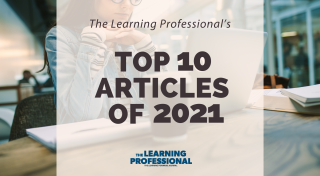Amid rising levels of educator burnout and turnover (ERS, 2023a, b; Kurtz, 2022), there has been a lot of talk about prioritizing educator wellness. Wellness means different things to different people, but many experts agree that true wellness isn’t about simply going to a yoga class or even taking a mental health day (Bell, 2023; Romero, 2023). It’s about a systemic approach that honors educators’ humanity and creates the working conditions that make for a manageable and satisfying profession. That takes a multifaceted approach that includes structural support like teacher teaming and substitute coverage, opportunities for growth and development, financial support, and supportive and collaborative organizational cultures.
Social and emotional learning (SEL) is one way of thinking about cultivating a systemic approach to wellness. SEL includes a broad set of cognitive, affective, interpersonal, and intrapersonal skills, including empathy, conflict resolution, stress management, attention, self-regulation, and self-control (Greenberg, 2023a; Jones et al., 2021). Those skills have sometimes been referred to as soft skills, but many educators and researchers argue that they are anything but because they have concrete applications and meaningful results (Edutopia, 2017; Jones et al., 2019). Decades of research confirm that SEL can lead to better outcomes in school, the workplace, and relationships (Greenberg, 2023a; Jones et al., 2021; Durlak et al., 2011).
Educators may not realize that research shows adults’ social and emotional skills are essential for successful teaching and learning, even though most teachers and principals recognize that students’ SEL skills are fundamental for learning and school success (Bridgeland et al., 2013; DePaoli et al., 2017; Hamilton et al., 2019). Not only do educators’ SEL skills allow them to model and teach those skills to students (Jennings & Greenberg, 2009; Mahoney et al., 2021), but they can also help educators navigate the needs and challenges of the profession and therefore reduce burnout and educator attrition. Four meta-analyses (which combine the results of multiple research studies) have found that SEL efforts for educators, like mindfulness programs and emotional awareness and regulation training, reduce educators’ stress and increase their effectiveness (Greenberg, 2023a).
SEL skills don’t develop in a vacuum — for adults or for students. Education leaders can’t simply tell teachers and principals to focus on SEL. They need to create opportunities to do so, model that commitment, and be intentional and reflective about the culture of the school, including during staff meetings, supervision, and other adult-focused interactions. They should also engage teachers, principals, and other staff in professional learning on SEL skills (Greenberg, 2023a; Mahfouz et al., 2019; Tosh, Schwartz, & Augustine (2022). Research shows that many teachers have little opportunity to learn about these skills either during preservice programs or ongoing professional learning, even when they are expected to implement an SEL curriculum (Greenberg, 2023a), suggesting there is a clear need to increase this kind of learning and support at all levels.
Important lessons about why and how to support adults’ SEL skills — and their implications for teachers’ well-being and career longevity — have emerged from the Partnerships for Social and Emotional Learning Initiative, an effort in six U.S. communities that was funded by The Wallace Foundation. One school profiled in a case study of the Tulsa effort found that staff burnout and turnover decreased noticeably after they spent time on SEL. The percentage of staff reporting they felt burned out dropped markedly, from 62% in spring 2018 to 29% in spring 2020, and the turnover rate also dropped from 33% to 23%. (Christianson et al., 2022).
One of the key lessons that came out of the Partnerships for Social and Emotional Learning Initiative is that adults’ SEL skills were vital to the success of the whole effort (Tosh, Schwartz, & Augustine, 2022). Leaders of the initiative point to an approach they call “sequencing,” through which intentional support can help educators develop SEL skills and, in turn, educators are then able to help students’ develop their skills. Sequencing is likely to help with cultivating wellness as well, because educators who put on their own oxygen masks first (so to speak) are better able to support students’ well-being.
Educators who put on their own oxygen masks first (so to speak) are better able to support students’ well-being. Share on XAnother lesson from the initiative was that short SEL rituals, like daily warm welcomes and optimistic closings, were often the first and most widely adopted strategies (Tosh, Schwartz, & Augustine, 2022). Those rituals are valuable for adults as well as students, as they can help everyone feel centered, connected to each other, and whole. Educators can benefit from engaging in those rituals not only during the school day with students, but also in staff meetings, professional learning, and other times.
The case studies also highlighted some additional SEL strategies that can be helpful for wellness. For example, in Tulsa, Oklahoma, some educators started a book club about SEL and engaged in Zoom sessions about stress management, “pint-sized” professional learning sessions such as “mindful Mondays” and “read and reflect Fridays” (Christianson et al., 2022). In Boston, Massachusetts, teachers engaged in SEL coaching, which not only supported their work with students but also gave them a chance to reflect on and reinforce their own skills (Tosh, Augustine, & Schwartz, 2022). In Palm Beach, Florida, school and after-school providers engaged in a course called Bringing Yourself to Work to learn about and reflect on how they think about and approach their work from a social and emotional perspective (Bouffard, 2021).
Other studies point out that district and school leaders are essential to establishing a culture of SEL and cultivating colleagues’ SEL skills in ways to lead to healthier, happier, and more sustainable workplace cultures. SEL experts Julia Mahfouz, Mark Greenberg, and Amanda Rodriguez (2019) call on principals to be “prosocial leaders whose responsibility is to ensure that all staff, students, parents, and community members feel safe, cared for, respected, and valued” (p. 3). They proposed a theoretical model that shows how principals’ social and emotional competencies and well-being influence all aspects of school culture and climate, including relationships, teacher well-being, family and community partnerships, and eventually teachers’ instruction and students learning outcomes. To teachers, this chain of effects is more than theoretical. They know that principals set the tone for the entire school, not just in instructional expectations but in how people treat one another and take care of themselves and each other. SEL is one way to bring intentionality to those interactions and cultivate everyone’s well-being.
District and school leaders can take a range of steps to integrate SEL into their support for educators and into their school cultures overall, from incorporating routines and rituals into staff meetings, to investing in SEL professional learning, to supporting all staff to implement SEL with students and in interactions with colleagues. During a recent webinar, Greenberg said that 25 years ago, he was told “that there would never be any time in education for this kind of work,” but, since research has shown benefits for adults and students, “now we have time for it. It’s doable.” Yet, he noted, even though studies “conclusively show that these [SEL] programs can improve teacher well-being … there are very few evidence-based educator-focused SEL programs being used in U.S. schools at this time” (Greenberg, 2023b).
To help schools and other youth-serving settings like afterschool programs integrate SEL into their work, The Wallace Foundation’s Knowledge Center includes a wealth of resources, including an SEL podcast with an episode on building adults’ capacity; lessons learned from case studies of the Partnerships for Social and Emotional Learning Initiative sites, and a comprehensive guide to implementing SEL in schools.
Social and emotional learning and skills alone will not solve the challenges facing the education workforce; no single strategy will. But they can and should be part of a systemic effort to support teachers and leaders, and they should undergird other efforts. SEL isn’t just about what we do, but how we do it, and how we approach educator wellness and retention matters.
References
Bell, J. (2023). Healing-centered environments fill gaps in educator wellness. The Learning Professional, 44(2), 18-19.
Bouffard, S. (2021). To make SEL stick, align school and out-of-school time. The Learning Professional, 42(4), 30-35.
Bridgeland, J., Bruce, M., & Hariharan, A. (2013). The missing piece: A national teacher survey on how social and emotional learning can empower children and transform schools. Civic Enterprises.
Christianson, K., Gomez, C.J., Augustine, C.H., & Schwartz, H.L. (2022). Learning to focus on adult social and emotional learning first in Tulsa. RAND Corporation.
DePaoli, J.L., Atwell, M.N., & Bridgeland, J. (2017). Ready to lead: A national principal survey on how social and emotional learning can prepare children and transform schools. Civic Enterprises.
Durlak, J.A., Weissberg, R.P., Dymnicki, A., Taylor, R.D., & Schellinger, K.B. (2011). The impact of enhancing students’ social and emotional learning: A meta-analysis of school-based universal interventions. Child Development, 82, 405-432.
Edutopia. (2017). It’s time to stop calling SEL “soft skills” [Video].
ERS. (2023a, May 11). Examining school-level teacher turnover trends: A new angle on a pervasive issue.
ERS. (2023b, May 24). Concerned about teacher retention in your district? Mitigate the turnover cycle by supporting your principals.
Greenberg, M.T. (2023a, March 6). Evidence for social and emotional learning in schools. Learning Policy Institute.
Greenberg, M.T. (2023b, April 27). The evidence is clear: An update on research examining social and emotional learning [Webinar]. CASEL.
Hamilton, L.S., Doss, C.J., & Steiner, E.D. (2019). Teacher and principal perspectives on social and emotional learning in America’s schools: Findings from the American Educator Panels.
Jennings, P.A. & Greenberg, M.T. (2009). The prosocial classroom. Review of Educational Research, 79(1), 491-525.
Jones, S.M., Bailey, R., Kahn, J., & Barnes, S. (2019, April 30). Social-emotional learning: What it is, what it isn’t, and what we know.
Jones, S.M., Brush, K.E., Ramirez, T., Mao, Z.X., Marenus, M., Wettje, S., Finney, K., Raisch, N., Podoloff, N., Kahn, J., Barnes, S., Stickle, L., Brion-Meisels, G., McIntyre, J., Cuartas, J., & Bailey, R. (2021). Navigating SEL from the inside out. The Wallace Foundation.
Kurtz, H. (2022, April 14). A profession in crisis: Findings from a national teacher survey. Results of the first annual Merrimack College Teacher Survey. EdWeek Research Center.
Mahfouz, J., Greenberg, M.T., & Rodriguez, A. (2019). Principals’ social and emotional competence: A key factor for creating caring schools. Edna Bennett Pierce Prevention Research Center, Pennsylvania State University.
Mahoney, J.L., Weissberg, R.P., Greenberg, M.T., Dusenbury, L., Jagers, R J., Niemi, K., Schlinger, M., Schlund, J., Shriver, T.P., VanAusdal, K., & Yoder, N. (2021). Systemic social and emotional learning: Promoting educational success for all preschool to high school students. American Psychologist, 76(7), 1128-1142.
Romero, V.E. (2023). To combat stress, create a resilient school community. The Learning Professional, 44(3), 14-15.
Tosh, K., Augustine, C.H., & Schwartz, H.L. (2022). Expanding social and emotional learning beyond the school walls in Boston: One of Six case studies of schools and out-of-school-time program partners.
Tosh, K., Schwartz H.L., & Augustine, C.H. (2022). Strengthening students’ social and emotional skills. RAND Corporation.









